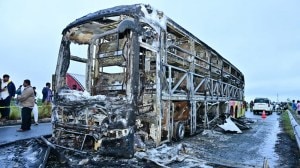Asian crisis hits world markets
LONDON/NEW YORK, Jan 9: For the fourth time in recent months the Asian crisis threatened to engulf world markets. In early trade markets acr...

LONDON/NEW YORK, Jan 9: For the fourth time in recent months the Asian crisis threatened to engulf world markets. In early trade markets across Europe fell sharply. In a repeat of the domino-effect the crisis led to a meltdown in the US markets on Thursday, which in turn saw European bourses opening sharply lower.
In Asia, the crisis extended to the fourth day on Friday, with the Singapore stock market slumping by 7.4 per cent, Hong Kong by 3.9 per cent, Malaysia by 3 per cent, Indonesia 1.2 per cent, Thailand 2.9 per cent, Shanghai B 3.8 per cent, Phillipin 8.3 per cent, South Korea, 2.9 per cent.
Rumours that the U S Federal Reserve had checked rates on Asian currencies overnight also kept traders on their toes, with some even citing the Fed’s presence behind the rupiah’s rebound of more than 30 per cent. A Fed spokesman declined comment on the rate checking rumours and most analysts were skeptical of the U S central bank intervention to shore up Asia’s sagging currencies.
“Nobody said they were hitin the market here … And if the Fed did come in, it would want the world to know,” said Ishak Ismail, market intelligence analyst in Singapore.
Dollar sales by state banks in Jakarta and follow-through selling by Singapore operators helped the rupiah fend off the impact of rumours about street demonstrations in Jakarta and the health of Indonesian Pressident Suharto. Both were denied by military and government officials.
Elsewhere, the Malaysian ringgit firmed to 4.5750/850 to the dollar from lows of around 4.7800, following intervention by the central bank and calming works by the country’s leader. The Singapore dollar also showed a slightly-healthier tone amid higher domestic interbank rates and talk of overnight intervention by the de facto central bank.
The Monetary Authority of Singapore intervened in thin overseas markets to defend the Singapore dollar.





- 01
- 02
- 03
- 04
- 05


























